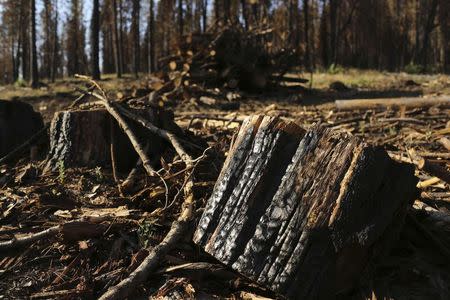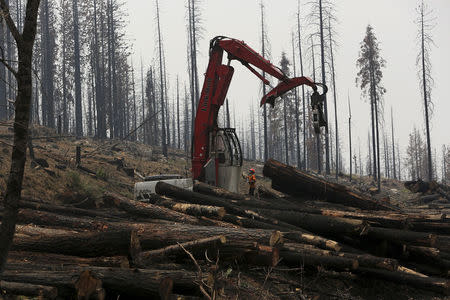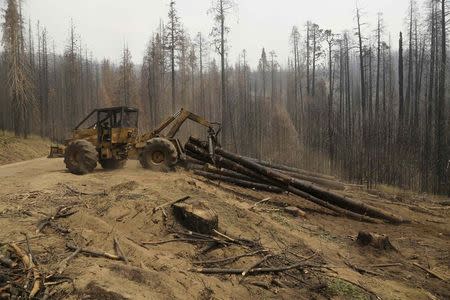Plan to sell burned California trees sends sparks flying
By Sharon Bernstein GROVELAND Calif. (Reuters) - Long, heavy logging trucks, swaying with the weight of charred California pines, wind through the forest near Yosemite National Park, part of an effort to clean up from last year’s devastating wildfires even as new blazes break out this summer. But as the U.S. Forest Service prepares to release plans this month for selling thousands of the burned trees to logging companies, conflict is brewing with residents who say the trucks are dangerous and environmentalists who fear the project is just an excuse for making money. "They're taking everything," said nature writer David Lukas, whose home in Groveland is not far from where the devastating Rim Fire charred 260,000 acres of public and private land in and around Yosemite in August 2013. "It's shocking." Lumber crews have already begun removing hundreds of burned trees at risk of falling on people and roads. On Aug. 22, the Forest Service will announce final plans for removing still more damaged trees, on up to 30,000 acres in the Stanislaus National Forest outside Yosemite park, and work could begin by the end of the month. Fire officials say the tree removal, to be paid for by the sale of the scorched trees, will help thin the forest to make future blazes less intense while providing jobs for loggers and protecting the public. But environmentalists worry that the Forest Service, eager for money from the sale of the salvaged trees, will remove too much precious habitat. The argument is taking place against a backdrop of increasing danger from wildfires throughout the western United States, and a fire season that is reaching its peak amid a devastating drought that has left dry, combustible fuel ready to burn. Over the past two months, wildfires have raged out of control in Oregon, Washington and California. Scientists say conditions will only worsen amid the drought, climate change and a reluctance to thin the forests due to concerns about the environment. FUEL FOR FUTURE BLAZES "The fires are more intense, more frequent and burning larger acreage," said Bruce Greco, spokesman for the Ecological Restoration Institute at Northern Arizona University, which researches wildfires. Decades of fighting all fires, instead of letting some burn naturally, protects homes that are increasingly being built near forested areas, but leaves too much fuel for future blazes, he said. In developing its plan, the Forest Service tried to balance its management of fire risk with environmental concerns and a goal of spurring economic growth in rural areas, said Robert Bonnie, who oversees the Forest Service as undersecretary of the U.S. Department of Agriculture. "It's not possible to satisfy everyone, but it is possible to create a management plan going forward that has strong scientific credibility," Bonnie said. Logging will not take place in Yosemite park itself. The Forest Service has not said how much money it expects to reap from the sale of trees, but environmental documents indicate that over the next 2-5 years, 661 million board-feet of timber could be recovered, enough to frame 55,000 houses. The logging would create 4,230 jobs in two counties, and state figures show that a similar amount of timber was worth about $100 million last year. Income from the sale would be used for forest restoration and fire prevention at the cash-starved Forest Service, which is expected to use half or more of its roughly $5 billion budget this year fighting fires. By comparison, just 15 percent of the budget went to firefighting 20 years ago, Bonnie said. Still, environmentalists would prefer to see more of the burned trees left in the forest to become habitat for wildlife, said Sierra Club representative Ani Kame'enui. "When you salvage trees you are disregarding the benefits of fire to that landscape," Kame'enui said. "Salvage logging is a highly controversial activity, rarely advocated for by the conservation community." The equipment used to remove the trees can be damaging to the soil, and the denuded land can be prone to landslides, she said. In the Stanislaus forest, where piles of logs as high as a two-story building sit in the middle of open clearings littered with tree stumps, the tracks of heavy equipment are clearly visible in the brown soil. Residents say logging trucks careen past them on narrow mountain roads, hurrying to drop off their loads. Some fear it will get worse if the Forest Service approves the massive salvage project this month. "Those trucks are dangerous," said Dawn Miller, who lives with her family in a forested area near Groveland. (The story is refiled to delete extraneous characters in quote in paragraph 17.) (Reporting by Sharon Bernstein; Editing by Jill Serjeant and Mohammad Zargham)







